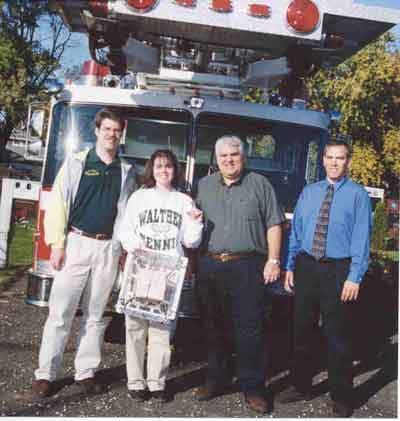911 Egg Drop?…maybe not
Egg Drop and the Fire Department
Contests can be a fun way to apply learned knowledge. Many physics and science teachers have adopted the egg drop contest, where the students have to build a device that will keep an egg from breaking after a big fall. This project can be used to assess student understanding after the force and motion unit while also teaching them basic engineering concepts. The idea here is for students to put into practice the concepts of gravity, acceleration, and force. You'll be amazed with the different ideas that the students come up with to save their eggs. There are many variations on the rules, and usually it's a good idea to change the rules from year to year. Don't have a place high enough to drop the eggs? Call the fire department. (use the non-emergency phone number and not 911 ;) ) They can bring a ladder truck and take your devices up 20 meters or so over the parking lot or a field. Call in advance because you may have to go through some red tape, but normally the department and the firefighters love doing it. It is also an opportunity for publicity – for the school and for the class.
Studying Color Subtraction
When talking about light and color, the concept of color subtraction can be confusing to students. The idea of adding a color as subtraction is kind of an oxymoron. One issue that comes up is how color printers work (and color pictures in magazines). A good color printer will use four colors of ink to make color photos: magenta, cyan, yellow, and black. (Remember that these are the primary subtractive colors.) The black is not always necessary, but it improves the detail in darker parts of the image. To get this point across in a concrete way, you can get our Color Filters Kit. Put them on top of each other one at a time on an overhead projector. The color photo will come to life, right in front of their eyes.
Earth and Space Science and the Helical Spring, "Snaky"
Not just for waves, anymore!
A commonly-known use of the snaky is to teach about waves. It works great for that, but did you know that you can teach Earth and Space Science with it as well? For instance, you can teach about the expansion of the universe and distance to galaxies (Hubble's Constant for you astronomy buffs.) Take the snaky and put about five Post-It® notes or pieces of paper along the length of it. It does not matter exactly where they are. Pick one of them to be the Earth. The others are galaxies. With the snaky held lightly between two people, measure the distances between the notes. Put a table of the distances on the board or overhead. Have the two people holding the spring take a step backward. Measure the distances again. Have them take another step back. Measure the distances again. With the table that you now have, show that the galaxies that are farthest from the Earth are moving away from the Earth the fastest (moved the most distance in the time). Try it again with the Earth in a different location. It still works! The Earth does not have to be in the center.
How about earthquakes and plate tectonics? Or demonstrate Elastic rebound theory? Attach the snaky to a box or other weighty object. Put the object on the floor (carpet works best). Pull the snaky slowly to the side (You can grab the snaky in the middle). If there is enough friction between the object and the floor, the object will stick for a while, then suddenly move. Keep going. It will jump, again, but maybe not as much or more than before. This shows that as the tectonic plates slide past each other, they stick. When enough stress builds up, the plates suddenly move: an earthquake. Some earthquakes are big, some are small. You will need to find the right size, weight, and material for your box. Otherwise, it will slide too easily or jump too much.
Cool Online Resources
|
My personal favorite website (well, at least for now) |
|
|
Here's an interesting site with lots of good animations |


